I just finished a 3-part series about the Ruth Bancroft Garden (RBG) in Walnut Creek so it may seem redundant to post even more photos. On the other hand, can there ever be too much of a good thing? I’ll let you be the judge of that.
The photos in this post were taken a couple of Saturdays ago on a somewhat unexpected second December visit. With some exceptions, they show different vignettes and plants than my other recent RBG posts.
 |
| Massive Agave salmiana ‘Variegata’ standing guard at the entrance to the garden on Bancroft Road. The tall columnar cactus next to the Visitor Center is Echinopsis terscheckii (aka Trichocereus terscheckii), sometimes called the Argentine saguaro because of its similar appearance. |
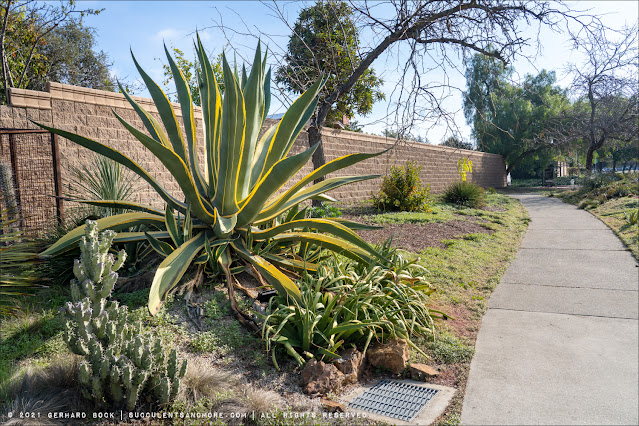 |
| Agave salmiana ‘Variegata’, looking southeast, away from the garden entrance |
 |
| I wonder how many people driving by (don’t) notice this agave flower stalk? |
The plantings around the new Visitor and Education Center fall in the “friendly” category: soft-leaved, and without spines or teeth that could hurt anybody—human, canine, or otherwise.
 |
| ×Mangave ‘Desert Dragon’, a complex Hans Hansen/Walters Gardens hybrid between Manfreda maculosa, Agave pablocarrilloi and Agave attenuata as the seed parent and ×Mangave ‘Bloodspot’ and Agave geminiflora as the pollen parent |
 |
| ×Graptoveria ‘Opalina’, a hybrid between Echeveria colorata and Graptopetalum amethystinum |
The prickly, spiny, and spiky plants the RBG is known for are waiting just beyond the Visitor Center:
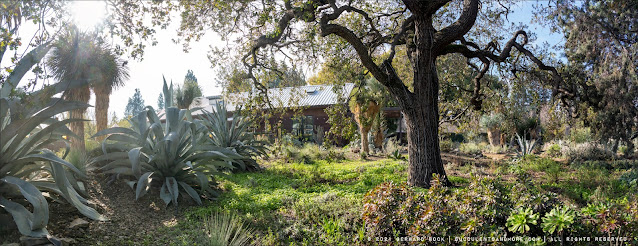 |
| Yucca rostrata and Agave franzosinii on the left, Visitor Center at center left, and a century-old valley oak (Quercus lobata) in the middle |
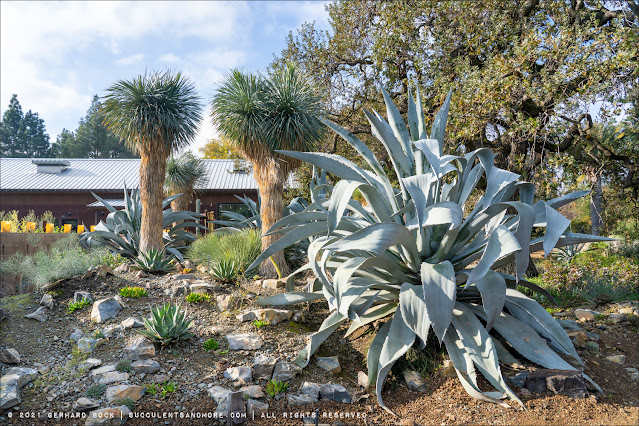 |
| Sentinels at the entrance to the garden: Yucca rostrata and Agave franzosinii |
 |
| Silver cacti glowing in the wintry morning sun |
 |
| Mammillaria geminispina is the best “glower” |
 |
| The same bed, looking in the opposite direction |
 |
| Golden barrels (Echinocactus grusonii) in the background, Echinopsis formosa (formerly Soehrensia formosa) in the front |
 |
| Shade structure over bed 6 (see this post for more photos of the inside) |
 |
| Flat boulders behind the shade structure. I don’t know if they’ve been placed like this deliberately—maybe as seating for outdoor presentations?—or if they’re just being stored here. What I wouldn’t give to have a few of these in my garden! |
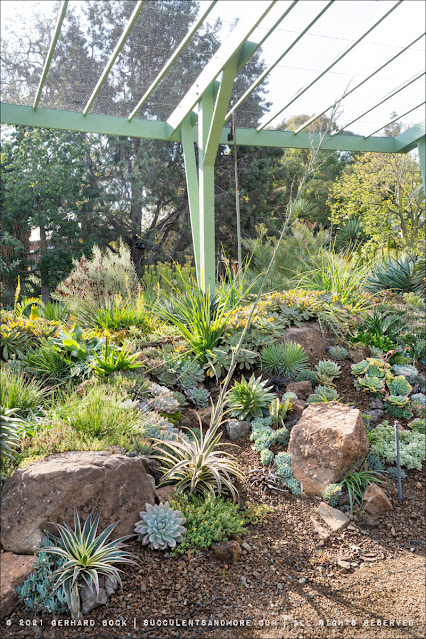 |
| ×Mangave ‘Snow Leopard’ with a comically tall and thin flower stalk |
 |
| Another ×Mangave ‘Snow Leopard’ near the flowering rosette above |
 |
| My favorite tree in the garden: Queensland bottle tree (Brachychiton rupestris) |
 |
| Agave potatorum with spines going every which way |
 |
Hakea is a lesser known genus in the protea family. The RBG has quite a few species in its collection. This is Hakea verrucosa from Western Australia.
|
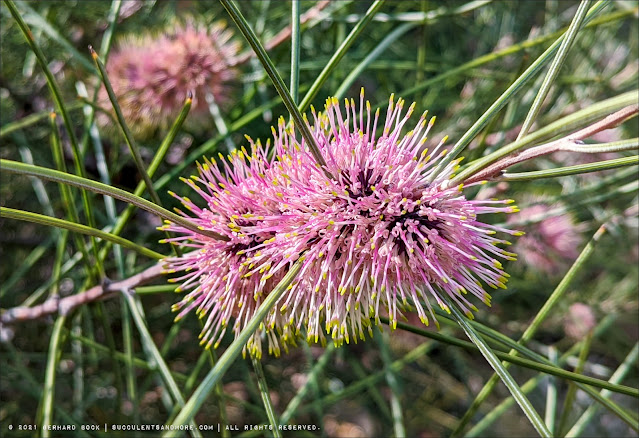 |
| Hakea pycnoneura, also from Western Australia |
 |
| Agave ‘Blue Glow’, axillary offsets after flowering |
 |
| Dramatically lit clump of fiber-optic grass (Isolepsis cernua) growing on a rock in the pond |
 |
| Aloe cheranganiensis (Kenya) |
 |
| ×Mangave ‘Mission to Mars’ in the foreground, with several others in the upper left |
Most of the mangaves available commercially, like ×Mangave ‘Mission to Mars’ above, come from Walters Gardens’ breeding program headed by Hans Hansen. But RBG curator Brian Kemble has been hybridizing manfredas and agaves for a number of years as well. Below are two of his mangaves.
#1 is ×Mangave ‘Purple Ribbons’, a hybrid between ×Mangave ‘Macho Mocha’ and Agave pablocarrilloi. Unfortunately, it has bloomed and is now dying:
 |
| ×Mangave ‘Purple Ribbons’ |
 |
×Mangave ‘Purple Ribbons’
|
#2 is ×Mangave ‘Blue Fountain’. The parents of ×Mangave ‘Blue Fountain’ are Agave parrasana and a manfreda hybrid of Brian’s called Manfreda ‘Dit Dah’. Brian named it ‘Dit Dah’ because the leaves have both dots and dashes. This made Brian think of Morse code, where “dits” are the short bursts of sound and “dahs” the long ones. Some of the resulting mangaves have dots, others (like the one in the photo below) have dashes. Brian’s goal is to cross both forms of ×Mangave ‘Blue Fountain’ in hopes of getting one that has both dots and dashes, just like its Manfreda ‘Dit Dah’ parent.
 |
| ×Mangave ‘Blue Fountain’ |
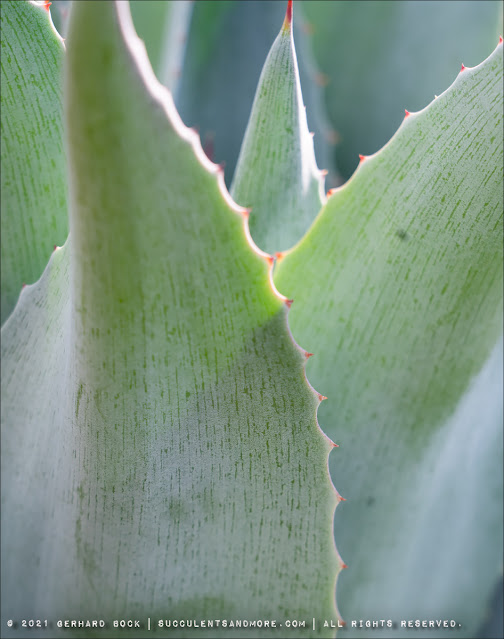 |
| ×Mangave ‘Blue Fountain’ showing the “dah” pattern (dashes) |

|
| Flowering ×Mangave ‘Blue Fountain’. The inflorescence is thicker than typically seen in mangaves (and definitely in manfredas), a trait inherited from the Agave parrasana parent. |
Continuing on:
 |
| A softer vignette featuring carex, an aeonium, echeveria hybrids, and Tradescantia pallida ‘Purple Heart’ |
 |
| Tradescantia pallida ‘Purple Heart’ surrounded by Sedum rubrotinctum |
 |
| Agave salmiana, one of the giants in the genus |
 |
| Yucca ‘Bright Star’ and Brachychiton rupestris |
 |
| Agave ovatifolia ‘Orca’, so beautiful and still so rare. ‘Flipper’ has the opposite pattern of variegation (creamy center, gray-green margins). |
 |
| Agave ‘Chocolate Edge’, a Agave mitis hybrid and one my very favorite aloes. It looks like a giant version of ×Mangave ‘Praying Hands’. |
 |
| Xanthorrhoea nana (front), a dwarf version of the Australian grass tree, and Furcraea macdougalii, considered to be the largest member of the Agavoideae subfamily |
 |
| The multi-stemmed aloe with orange flowers is Aloe ‘Tangerine’, a hybrid between Aloe ferox and Aloe arborescens. Yes, ‘Tangerine’ will eventually be this tall! |
 |
| Lone agave amongst the aloes: Agave salmiana var. ferox ‘Mediopicta’ |
And finally a few photos from the parking lot. I suspect that like me, most visitors don’t pay much attention to the plants growing along the fence line. But there are some interesting sights that are worth a closer look.
 |
| Senecio ficoides ‘Skyscraper’ (aka ‘Mount Everest’) seems to have proven itself at the RBG. I’ve noticed in it several spots through the garden. |
 |
| An octopus-like Agave americana ‘Marginata’ amidst a clump of Puya violacea |
 |
| Another Agave americana ‘Marginata’, its tentacles spilling into the parking lot |
 |
| I love photographing cactus warning signs ☺ |
On that note, love your prickly plants, but don’t get too close!
RELATED POSTS:
© Gerhard Bock, 2021. All rights reserved. To receive all new posts by email, please subscribe here.















































Taking note of 'Tangerine's eventual size! This was a treat, Gerhard -- Happy New Year's Eve!
ReplyDeleteThe size of 'Tangerine' surprised me--stunned me, even. I have mine planted right up against the front yard fence!
DeleteYes, it certainly is a treat! Thanks, Gerhard!
ReplyDeleteGlad you enjoyed this encore visit!
DeleteFabulous photos well worth another post! When I saw those flat boulders I had exactly the same thought as you did before I even read your comment. I love Mangave 'Blue Fountain' and hope to find that in cultivation one day.
ReplyDeleteBest wishes for a happy new year!
I also hope that Brian Kemble's hybrids will become available for purchase. He's created so many beautiful hybrids....
DeleteThanks for the tour Gerhard!
ReplyDeleteI particularly like the wide shots in this post as they help me to understand the garden layout and get orientated. Your RBG posts are the perfect accompaniment to Johanna Silver and Marion Brenner’s exceptional book on the topic, which is incidentally my current summer read!
And a very Happy New Year to you and yours! 🌵 🎉
DeleteHappy New Year to you as well! I love Johanna Silver's book, too. I refer to it all the time for historical facts about the garden.
DeleteThat Queensland bottle tree is all I'd need in my back garden to be happy. That, a bird bath and a recliner. The most surprising photo today is the clump of fiber-optic grass... on a rock... in the pond. Great photo of a unique plant placement. Happy New Year!
ReplyDeleteThe garden is full of unique vignettes like that. And I keep discovering new ones each time I visit!
DeleteHappy New Year to you, too!!
Really enjoyed this photos. I do not tire of seeing scenes from the RBG. Thank you!
ReplyDelete